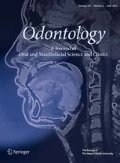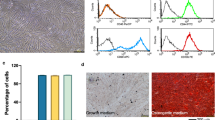Abstract
To determine the adverse effects against human dental pulp tissue, the sensitivity of human dental pulp cells (D824 cells) to 18 chemical agents used for endodontic treatments in dentistry was examined. The cytotoxicity, as determined by a decrease in colony-forming ability of cells treated with the chemical agents, increased as the concentration increased. As a quantitative measure of the cytotoxic effect, LC50, the concentration which induces a 50% lethality, was extrapolated from the concentration–response curves. The rank of the chemical agents according to their cytotoxic effect (LC50) was sodium arsenite > formaldehyde > hydrogen peroxide > zinc oxide > thymol ≈ iodoform ≈ eugenol > guaiacol > ethylenediaminetetraacetic acid ≈ iodine > procaine > lidocaine ≈ chloramphenicol ≈ m-cresol > calcium hydroxide ≈ sodium hypochlorite ≈ phenol ≈ p-phenolsulfonic acid. To compare the cytotoxicity and the levels of apoptosis and mRNA expression of five genes related to the function of dental pulp tissue, D824 cells treated with the LC50 concentrations of chemical agents were assayed by the TUNEL method and quantitative reverse transcription polymerase chain reaction analysis, respectively. The inducibility of apoptotic cells and the level of mRNA expression of the genes varied with the chemical agents, indicating that both effects occurred independent of the rank of cytotoxic effect of the chemical agents. The results not only provide information concerning cytotoxicity of various chemical agents to human dental pulp cells, but also show an insight into the diversity of the pharmacodynamic action of the chemical agents.



Similar content being viewed by others
References
Bartelstone HJ. Radioiodine penetration through intact enamel with uptake by bloodstream and thyroid gland. J Dent Res. 1951;30:728–33.
Myers DR, Shoaf HK, Dirksen TR, Pashley DH, Whitford GM, Reynolds KE. Distribution of 14C-formaldehyde after pulpotomy with formocresol. J Am Dent Assoc. 1978;96:805–13.
Gronthos S, Mankani M, Brahim J, Robey PG, Shi S. Postnatal human dental pulp stem cells (DPSCs) in vitro and in vivo. Proc Natl Acad Sci USA. 2000;97:13625–30.
Seo BM, Miura M, Gronthos S, Sartold PM, Batouli S, Brahim J, Young M, Robey PG, Wang CY, Shi S. Investigation of multipotent postnatal stem cells from human periodontal ligament. Lancet. 2004;364:149–55.
Tsutsui TW, Inaba T, Fisher LW, Robey PG, Tsutsui T. In vitro chromosome aberration tests using human dental pulp cells to detect the carcinogenic potential of chemical agents. Odontology. 2006;94:44–50.
Gronthos S, Brahim J, Li W, Fisher LW, Cherman N, Boyde A, DenBesten P, Robey PG, Shi S. Stem cell properties of human dental pulp stem cells. J Dent Res. 2002;81:531–5.
Tompson CB. Apoptosis in the pathogenesis and treatment of disease. Science. 1995;267:1456–62.
Tsutsui T, Hayashi N, Maizumi H, Huff J, Barrett JC. Benzene-, catechol-, hydroquinone- and phenol-induced cell transformation, gene mutations, chromosome aberrations, aneuploidy, sister chromatid exchanges and unscheduled DNA synthesis in Syrian hamster embryo cells. Mutat Res. 1997;373:113–23.
Hamaguchi F, Tsutsui T. Assessment of genotoxicity of dental antiseptics: Ability of phenol, guaiacol, p-phenolsulfonic acid, sodium hypochlorite, p-chlorophenol, m-cresol or formaldehyde to induce unscheduled DNA synthesis in cultured Syrian hamster embryo cells. Jpn J Pharmacol. 2000;83:273–6.
Takahashi M, Barrett JC, Tsutsui T. Transformation by inorganic arsenic compounds of normal Syrian hamster embryo cells into neoplastic state in which they become anchorage-independent and cause tumors in newborn hamsters. Int J Cancer. 2002;99:629–34.
Yamaguchi F, Tsutsui T. Cell-transforming activity of fourteen chemical agents used in dental practice in Syrian hamster embryo cells. J. Pharmacol Sci. 2003;93:497–500.
Hikiba H, Watanabe E, Barrett JC, Tsutsui T. Ability of fourteen chemical agents used in dental practice to induce chromosome aberrations in Syrian hamster embryo cells. J Pharmacol Sci. 2005;97:146–52.
Miyachi T, Tsutsui T. Ability of 13 chemical agents used in dental practice to induce sister-chromatid exchanges in Syrian hamster embryo cells. Odontology. 2005;93:24–9.
Hagiwara M, Watanabe E, Barrett JC, Tsutsui T. Assessment of genotoxicity of 14 chemical agents used in dental practice: ability to induce chromosome aberrations in Syrian hamster embryo cells. Mutat Res. 2006;603:111–20.
Nishimura H, Higo Y, Ohno M, Tsutsui TW, Tsutsui T. Ability of root canal antiseptics used in dental practice to induce chromosome aberrations in human dental pulp cells. Mutat Res. 2008;649:45–53.
Someya H, Higo Y, Ohno M, Tsutsui TW, Tsutsui T. Clastogenic activity of seven endodontic medications used in dental practice in human dental pulp cells. Mutat Res. 2008;650:39–47.
Beertsen W, VandenBos T, Everts V. Root development in mice lacking functional tissue non-specific alkaline phosphatase gene: inhibition of acellular cementum formation. J Dent Res. 1999;78:1221–9.
Goldberg M, Six N, Decup F, Lasfargues J-J, Salih E, Tompkins K, Veis A. Bioactive molecules and the future of pulp therapy. Am J Dent. 2003;16:66–76.
Hietala E-L, Larmas M, Salo T. Localization of estrogen-receptor-related antigen in human odontoblasts. J Dent Res. 1998;77:1384–7.
Dale JB, Sarich SL, Brets TM, Hatton JF, Zachow RJ. Hormonal regulation of androgen receptor messenger ribonucleic acid expression in human tooth pulp. J Dent Res. 2002;81:360–5.
Jukić S, Prpić-Mehičić G, Talan-Hranilovć J, Miletić I, Šegović S, Anić I. Estrogen receptors in human pulp tissue. Oral Surg Oral Med Oral Pathol Oral Radiol Endod. 2003;95:340–4.
Riggs BL, Khosla S, Melton LJ. Sex steroids and the construction and conservation of the adult skeleton. Endocr Rev. 2002;23:279–302.
Hietala E-L, Larmas M. The effect of ovariectomy on dentin formation and caries in adult rats. Acta Odontol Scan. 1992;50:337–43.
Molsted K, Kjaer I, Giwercman A, Vesterhauge S, Skakkebaek NE. Craniofacial morphology in patients with Kallmann’s syndrome with and without cleft lip and palate. Cleft Palate Craniofac J. 1997;34:417–24.
Renton T, Yiangou Y, Baecker PA, Ford AP, Anand P. Capsaicin receptor VR1 and ATP purinoceptor P2X3 in painful and nonpainful human tooth pulp. J Orofac Pain. 2003;17:245–50.
Caterina MJ, Schumacher MA, Tominaga M, Rosen TA, Levine JD, Julius D. The capsaicin receptor: a heat-activated ion channel in the pain pathway. Nature. 1997;389:816–24.
Chaudhary P, Martenson ME, Baumann TK. Vanilloid receptor expression and capsaicin excitation of rat dental primary afferent neurons. J Dent Res. 2001;80:1518–23.
Galloway SM, Aardema MJ, Ishidate M Jr, Ivett JL, Kirkland DJ, Morita T, Mosesso P, Sofuni T. Report from working group on in vitro tests for chromosome aberrations. Mutat Res. 1994;312:241–61.
Maizumi N, Tamura Y, Kanai H, Tsutsui T. Quantitative comparison of the cytocidal effect of seven macrolide antibiotics on human periodontal ligament fibroblasts. J Periodont Res. 2002;37:250–4.
Hirose Y, Tsutsui TW, Ohno M, Barrett JC, Tsutsui T. Effects of a catechol-O-methyltransferase inhibitor on catechol estrogen-induced cellular transformation, chromosome aberrations and apoptosis in Syrian hamster embryo cells. Int J Cancer. 2007;120:1627–33.
Tsutsui T, Suzuki N, Maizumi H, Barrett JC. Comparison of human versus Syrian hamster cells in culture for induction of mitotic inhibition, binucleation and multinucleation, following treatment with four aneuploidogens. Toxicol In Vitro. 1990;4:75–84.
Kato T, Shirayama K, Tsutsui TW, Tsutsui T. Induction of mRNA expression of osteogenesis-related genes by guaiacol in human dental pulp cells. Odontology. 2010;98:165–9.
Al-Awadhi S, Spears R, Gutmann JL, Opperman LA. Cultured primary osteoblast viability and apoptosis in the presence of root canal sealers. J Endod. 2004;30:527–33.
Kitamura C, Ogawa Y, Morotomi T, Terashita M. Differential induction of apoptosis by capping agents during pulp wound healing. J Endod. 2002;29:41–3.
Suzuki H, Seto K, Mori M, Suzuki M, Miura S, Ishii H. Monochloramine induced DNA fragmentation in gastric cell line MKN45. Am J Physiol. 1998;275:G712–6.
Bashir S, Sharma Y, Irshad M, Nag TC, Tiwari M, Kabra M, Dogra TD. Arsenic induced apoptosis in rat liver following repeated 60 days exposure. Toxicology. 2006;217:63–70.
Zararsiz I, Kus I, Ogeturk M, Akpolat N, Kose E, Meydan S, Sarsilmaz M. Melatonin prevents formaldehyde-induced neurotoxicity in prefrontal cortex of rats: an immunohistochemical and biochemical study. Cell Biochem Funct. 2007;25:413–8.
Lee SH, Heo JS, Lee MY, Han HJ. Effect of dihydrotestosterone on hydrogen peroxide-induced apoptosis of mouse embryonic stem cells. J Cell Physiol. 2008;216:269–75.
Yoo C-B, Han K-T, Cho K-S, Ha J, Park H-J, Nam J-H, Kil UH, Lee KT. Eugenol isolated from the essential oil of Eugenia caryophyllata induces a reactive oxygen species-mediated apoptosis in HL- 60 human promyelocytic leukemia cells. Cancer Lett. 2005;225:41–52.
Xu J, Liu X, Yang X, Li X. Study on the effect of iodine excess on cell apoptosis in rat thyroid cells (FRTL). Wei Sheng Yan Jiu. 2007;36:443–5.
Werdehausen R, Braun S, Essmann F, Schulze-Osthoff K, Walczak H, Lipfert P, Stevens MF. Lidocaine induces apoptosis via the mitochondrial pathway independently of death receptor signaling. Anesthesiology. 2007;107:136–43.
Popadic S, Popadic D, Ramic Z, Stojkovic MM, Trajkovic V, Milinkovic M, Medenica L. Chloramphenicol induces in vitro growth arrest and apoptosis of human keratinocytes. Cell Biol Toxicol. 2006;22:371–9.
Stanley HR, Clark AE, Pameijer CH, Louw NP, et al. Pulp capping with a modified bioglass formula (#A68-modified). Am J Dent. 2001;14:227–32.
Lei J, Da-Peng C, Lu-Ping Q, Ting H, Qiao-Yan Z, Zheng Z, Fei Y. Antiosteoporotic activity of phenolic compounds from Curculigo orchioides. Phytomedicine. 2009;16:874–81.
Moriguchi N, Hinoi E, Takarada T, Matsushima N, Uno K, Yoneda Y. Oral administration of phenolic antidiarrheic ingredients prevents ovariectomy-induced bone loss. Biochem Pharmacol. 2007;73:385–93.
Puel C, Mardon J, Agalias A, Davicco M-J, Lebecque P, Mazur A, Horcajada M-N, Skaltsounis A-L, Coxan V. Major phenolic compounds in olive oil modulate bone loss in an ovariectomy/inflammation experimental model. J Agric Food Chem. 2008;56:9417–22.
Pienta RJ, Poiley JA, Lebherz WBIII. Morphological transformation of early passage golden Syrian hamster embryo cells derived from cryopreserved primary cultures as a reliable in vitro bioassay for identifying diverse carcinogens. Int J Cancer. 1977;19:642–55.
Author information
Authors and Affiliations
Corresponding author
Rights and permissions
About this article
Cite this article
Kobayashi, M., Tsutsui, T.W., Kobayashi, T. et al. Sensitivity of human dental pulp cells to eighteen chemical agents used for endodontic treatments in dentistry. Odontology 101, 43–51 (2013). https://doi.org/10.1007/s10266-011-0047-9
Received:
Accepted:
Published:
Issue Date:
DOI: https://doi.org/10.1007/s10266-011-0047-9




